
|

|
The cars that
follow are cars of great integrity. Motorcars that have contributed much to the Motor Industry over the
years. They may be old or new, it dosen't really matter, what matters is that they blend beauty and power, grace and
pace, and that they inspire. These cars live in a world that can only be understood by the ones who know them best,
the followers, the car enthusiasts. Enjoy these Motoring Milestones and if you encounter any problems
or just want information then please contact me at webmaster@enzoheaven.co.uk

Aston Martin are one of the most powerful,
interesting and evocative car makers in the world today. Aston Martin's are also made in the UK, so there is an English
heritage about them. They look beautiful and exciting. The designs are well thought out masterpieces, they really
are fantastic machines. The best-selling and thus most popular Aston Martin of all time is the DB7, and that is
partly why I have chosen to put it on this page. The other reason is its pure beauty and prowess. It has a rare
quality that canno't be seen in many production cars today. It just seems right, everything about it makes sense. Aston
Martin have a fantastic, long history and it will continue for a long while yet.
| Aston Martin DB7 Vantage 6.0 V12 |
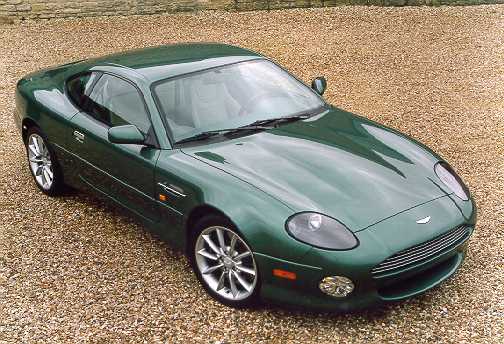
|
Ahhhhh, the Aston Martin DB7, thought of by many
people to be the most beautiful car currently in production. The design borrows largely from the Jaguar XK8/XKR
and thus looks devine, it's curves and flanks look superb, and together with those wheels and that gorgeous 6.0 V12 it's a
monster of a car. The DB7 has always been renowned for its superb
balance of ride and handling and this has been even further enhanced in DB7 Vantage with revised steering, suspension geometry
and re-tuned springs and dampers. Rear suspension linkages have been specifically redesigned to ensure smooth power delivery.
New lightweight alloy road wheels improve brake cooling whilst new wider, lower profile tyres (245/40 ZR 18 front, 265/35
ZR 18 rear) offer significantly more grip without compromise to ride quality. A 293 mm diameter single dry plate clutch is
hydraulically actuated via a concentric slave cylinder and transmits engine power to a uniquely developed 6 speed close ratio
gearbox providing clean, swift gear changes.
| Aston Martin DB7 Vantage Volante 6.0 V12 |

|
DB7s place in the Aston Martin story is as simple
as it is significant. As successor to the famous DB cars of the 1950s and 60s, the DB7 represents a natural evolution to all
those classic Aston Martins that have gone before it. With DB7 Vantage, this evolution goes one stage further. With its 420
bhp (309kW) all alloy, four camshaft, 48 valve, 6-litre V12 engine, six speed manual or five speed automatic with optional
Touchtronic transmission, DB7 Vantage is the fastest and most powerful DB of them all. At the heart of every Aston Martin
Vantage is an engine developed with ultimate performance in mind and DB7 Vantage is no exception. Unlike previous Vantages
with tuned versions of standard production engines, DB7 Vantage is powered by an all new engine which, for the first time
in Aston Martins history, has twelve cylinders. Developing 420 bhp (309 kW) at 6000 rpm, the new engine powers DB7 Vantage
to a top speed in excess of 180 mph (290 km/h). 0-30 mph (48 km/h) takes only 2.1 seconds, with 62 mph (100 km/h) coming up
in just 5.0 seconds. The benchmark 0-100 mph (160 km/h) sprint can be achieved in a stunning 11.4 seconds. In addition to
producing supreme levels of outright power, the new 6.0 litre V12's flat torque curve ensures truly impressive "real world"
performance where 85% of maximum torque is delivered at only 1500 rpm.
| Aston Martin DB7 Vantage 6.0 V12 |
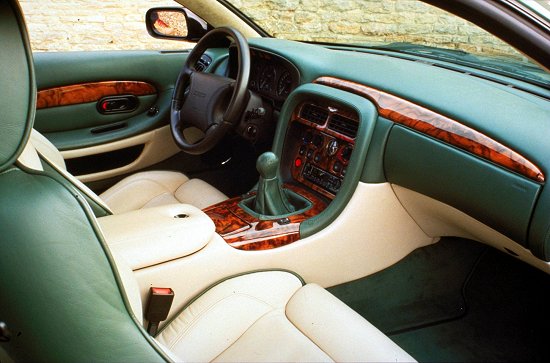
|
This exciting new engine is the direct result of
advanced computer aided design and engineering techniques coupled with the extensive use of high grade aluminium alloys to
optimise strength, rigidity, durability and refinement within an extremely lightweight, compact and efficient design. Race
derived engine features such as oil jet cooled pistons and tubular equal length stainless steel exhaust manifolds combine
with advanced emission technologies such as ionisation misfire detection, advanced metallic substrate catalysts and a specially
developed dual processor EEC V electronic engine management system. Designed for all markets, DB7 Vantage exceeds all worldwide
emission standards. Although the heart of an Aston Martin is the engine, DB7 Vantage offers far more. Suspension, brakes and
electronic traction control system have all been specifically developed to match the outstanding performance of the new V12
engine. Massive ventilated cross-drilled discs with aluminium four piston calipers combine with four channel electronic ABS
to provide immense stopping power. A limited slip differential and new rear axle mountings ensure optimum traction. Where
conditions require, the advanced switchable traction control system intervenes, instantly reducing engine power and, through
the ABS system, simultaneously applying the appropriate rear brake to restore grip.
| Aston Martin DB7 Vantage Volante 6.0 V12 |
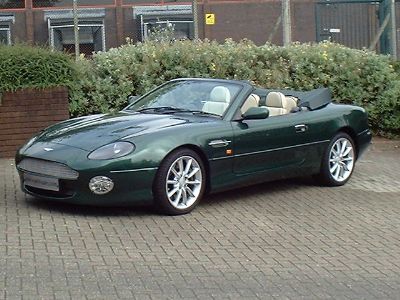
|
At long last, after a wait of six years, the
Vantage version of the DB7 was unveiled at the 1999 show. Restyled by the original designer, Ian Callum (Now Jaguars designer)
the exquisite poise of the DB7 is transformed with bigger, wider flanks, new sills, larger nose air intake with revised
grill and lights plus a new rear bumper. Although all DB7 models are built at Bloxham in Oxfordshire, DB7's are regularly
to be seen at the Newport Pagnell factory. Works Service is responsible for fitting special upgrades and servicing for all
DB7 models. Deliveries began during the Autumn of 1999. The DB7 Vantage Volante is probably the fastest open top Aston Martin
- ever. Launched simultaneously with the coupe version at the 1999 Geneva Motor Show, the Volante shares the body, chassis
and engine modifications of the closed version. The DB7 Vantage and Vantage Volante were displayed at the 2000 Geneva
Motor Show complete with the new Touchtronic transmission system developed in conjunction with ZF. As well as the conventional
floor mounted lever the driver can change both up and down by using '+' and '-' buttons mounted on the steering wheel.
| Aston Martin DB7 Vantage 6.0 V12 |
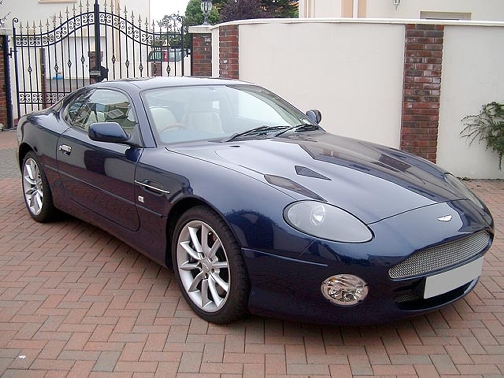
|
Let me make two VERY important points here and now - 1. The DB7 is the prettiest car in the
world - timeless without looking retro. 2. The DB7 is not a Jaguar. OK so it might have borrowed some bits
but that's exactly what Aston Martins have always done. Wasn't the first Aston Martin derived from a Singer? Did the DB2 have
a Lagonda engine? Yes to both questions. The coupe version of the DB7 was joined by the convertible Volante in 1996; a car
in great demand within the US marketplace. For those owners who need a little more, Works Service provide a Driving Dynamics
package of enhancements. But the icing on the cake was the V12 engined Vantage unveiled at the 1999 Geneva Motor Show. "The
Aston Martin DB7 is the most successful Aston Martin of all-time," says Mr Robert Dover Chairman and Chief Executive of Aston
Martin Lagonda. "In its Vantage form this latest DB7 has been designed to provide its owner with unparalleled levels of power,
performance and driving satisfaction. It complements the existing range of 335 horsepower six cylinder supercharged DB7 models
which continue to be available." In the United States the price of the Coupe is $140,000 and that for the Volante $150,000.
The DB7 Vantage, available in both Coupe and Volante body styles, is being offered for sale to customers in 31 different countries
throughout the world.

Porsche means to me, what Buckingham Palace means
to London. To me, there would not be an automotive industry without Porsche. The Porsche 911 makes up a huge section
of Porsche Worldwide, both in their sales and their reputation. This is why I choose to dedicate some of the space on
this page to a motoring legend, The Porsche 911. The company would not be the same without this car, and that is why you can
still buy it today, nearly half a century after it went on sale. It's a special car, for a special company. If there is anyone
who just has the slightest interest in what I am saying and is considering researching or finding out about Porsche and the
911, then please do. Because, as with anything, until you find out about it, you don't know what your missing.
| Porsche 911 Carrera 4S |
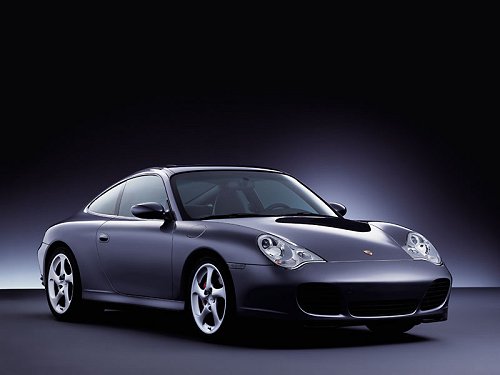
|
There's nothing quite like a Porsche 911. Every
one made is a car with extraordinary character. You either love it or hate it. There is no emotional comprimise with a Porsche
911. It understeers, it oversteers, it costs a fortune, it's front seats are superb, it's luggage space is restricted, and
it's back seats are a challenge. There are dozens of optional extras to confuse the customer. What makes a Porsche 911 so
attractive and why has it acquired such a fanatical following? First it has incredibly sensitive handling. With the combined
weight of the engine and transmission concentrated at the back, the rear end swings round very fast when cornering, particularly
with the earlier cars which had narrow tyres and little grip. This characteristic can be used to advantage by a very good
driver but can be deadly for the one who isn't. A touch too much acceleration and the ordinary driver is out of control, especially
in the wet. The only safe way for him to drive a 911 is slow into a corner and fast out. Fast in and fast out needs a touch
of a master. For years, rally drivers have used this tail-happy handling to great effect, swinging their 911's round endless
hairpins, and driving with a combination of superb throttle control and extremely sensitive steering. The steering on a 911
is light and precise, and this is partly due to so much weight being concentrated at the back. This rearward weight concentration
has another great advantage; it improves the traction. The tyres of a 911 grip so well in a straight line that once the car
is underway the acceleration is enormous.
| Porsche 911 Carrera |
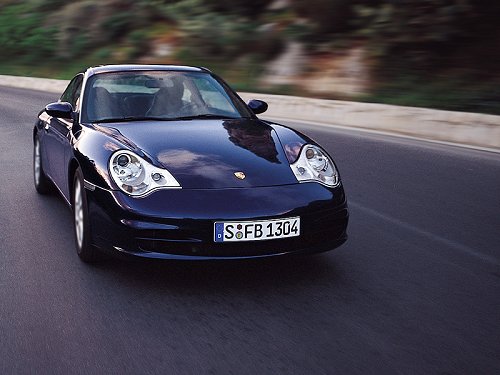
|
Getting the car under way can be a problem, however,
particularly with modern 'sticky' tyres. Again, the driver must be sensitive. Drop the clutch at exactly the right number
of revs and the 911 takes off like a rocket. Too little or too many revs and it's a waste of time. The engine either stutters
as though it is going to stall or the tyres spin madly with the car hardly moving. With the older 911 on their narrow wheels,
spinning was a matter of course when taking off fast. Now you can stall the car too, such is the grip of it's wide wheels
with modern rubberware. It's things like this that make the 911 so sensuous. Get it right and every moment is supremely satisfying;
get it wrong and it's frustrating. If your the sort of person who is willing to keep trying until you get it right every time
then your the sort who loves a Porsche 911. But if you want a car that will do it all for you with hardly any contribution
from yourself, then it would not suit you at all. Some people spend a lifetime trying to get it right, and some people just
give up and buy a different car. The second reason for the 911's continued popularity is that the performance is truely phenomenal.
Even the most mundane 911 goes like a bat out of hell, thanks to the race-bred precision of it's Teutonic engineering, and
the performance that has become more manageable over the years. The first Porsche 911's introduced in 1964 had high-revving
engines with relatively-little pulling power or torque, low down in their range. This was especially noticeable with the high
performance 'S' model introduced in 1967. The engines capacity was gradually increased to make it more flexible and the performance
went up with it.
| Porsche 911 Carrera Convertible |
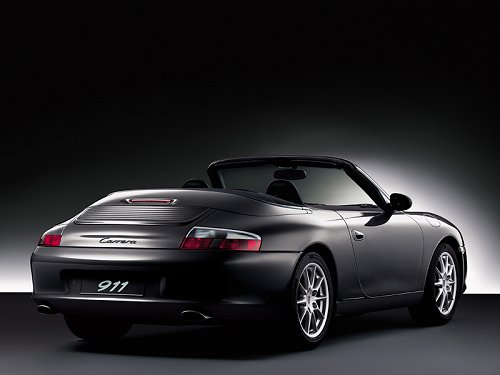
|
It all started so simply: there was only one
911 from which to choose. It was based on the 901 Prototype which had been designed on principles laid down by Dr Ferry Porsche,
son of the firms founder. He had been closely involved with the development of the Type 356, which had established Porsche's
name along the top flight of sports cars. The body was, in turn, designed by Ferry's son, also called Ferdinand, but known to
everybody as 'Butzi' Porsche. One of Dr Ferry Porsche's stand points was that the new Porsche must be about the
same size as the existing Type 356. It must also be a two-plus-two and as Porsche had made their name with rear-engined
air-cooled cars, thats how the new 901 turned out. Dr Ferry Porsche allowed a longer wheelbase - 87 inches longer than the
Type 356 - because it would make the car more comfortable in terms of ride and interior accommodation, without increasing
it's outward size too much. Butzi Porsche was so successful at carving away the 356's bulbous curves to form the definitive
911 shape that the result was 2.4 inches narrower and only 6 inches longer. This stretching and squeezing was aimed at enlarging
the interior space without increasing wind resistance. A true measure of Butzi's success can be seen from the length of time
the 911 shape has been in production. The 901 had a wheelbase of 7ft 3.05 inches, length of 13ft 7.9 inches, and width of
5ft 3.4 inches. Everything about the 911-to-be was aimed at saving space. Torsion bar suspension was retained all round and
the engine was still hung at the back with it's tall cooling fan behind the rear axle so that the car could have vestigal
rear seats. Putting the engine as far away from the car's occupants as possible also had the beneficial effect of isolating
them better from the noise: an important factor with an alloy engine that has no water jackets to absorb some of the sound.
| Porsche 911 GT3 |

|
The rearward weight distribution that presented
such problems with the 911 for use on the road has generally had the opposite effect in competition, where it has been a positive
advantage. The resulting tremendous traction and controllability has led to a seemingly never-ending succession of victories
in all manor of competitions; from circuit racing to rallying and even off-road events. In essence, the competition 911's
split into the following groups: the early lightweight road and rally cars, the Safari and off-road specials; the track-racing
Carreras; the rally Carreras; the club competition cars and the turbocharged machines. The apparent versatility of the
911 is hardly surprising when it is realised that the car was designed from the start to be equally suitable for competition
and series production. The 993 Porsche 911 was made in 1993, the '93 was included in the model name (993) All
in all this 911 is often seen as the 'new 959'. I haven't earlier mentioned the 959, because it's no 'real 911', but if one
writes about Porsche one cannot omit the 959. Derived from the 911 in 1985, it contained all the high-tech that Porsche had
and was (and is still) seen as a super car. Often referred to as 'Porsche's gift to the customers' this car actually wasn't
really designed for high sales, rather for racing. A specially prepared version even won Paris-Dakar two times (Porsche's
first big rally-success!) All pictures of 911's shown on this website are up-to-date 2003 model 996 911's.
| Porsche 911 Turbo |

|
The Porsche 911 has always used the Flat-6 engine,
and will continue to do so until the company feel that they have found something a little bit more special. There is talk
that they are going to put a V8 into the next generation 911, this would either be good or bad, but judging by Porsche's standards
at present, it can only be a good thing. The 911 is such a special car, I suppose it's just one of those things that, if you
can afford it, will get you up on those cold, dark, winter mornings. That is, if you dare to drive one in the winter! It's
a legend, and a motoring milestone. The Porsche 911.
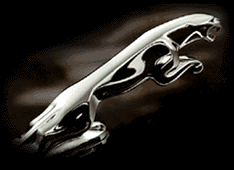
Jaguar are one of my favourite car makers.
They have made cars that have beauty, cars that have power, cars that have changed history and cars that everybody talks
about. There are only two cars they have made that combine all of these things, one I have already talked about - The
Jaguar E-Type. The other is something a little special, it's the one and only Jaguar XJ220. This car made history for Jaguar,
it is the fastest ever production Jaguar and will take some beating for future cars. Jaguar's are made in this country and
just belong here. They fit in, and will continue making some of the best cars in the world. They are part of an elite force
of car makers that are all part of this country. For very good reasons, the XJ220 will feature below.
| Jaguar XJ220 |
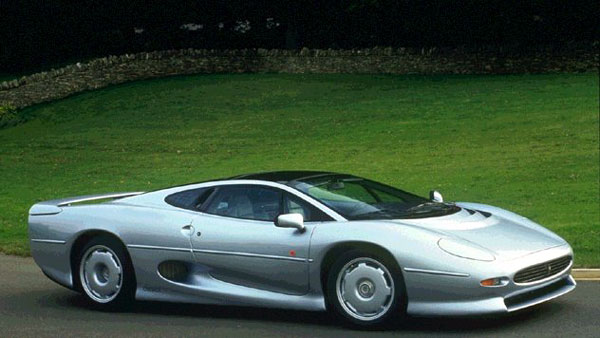
|
Sensation at the 1988 Birmingham Motor Show,
the XJ220 aimed to set new standards of road-going performance with a 500bhp V-12 Jaguar engine mounted amidships and mated
to a complex 5-speed four-wheel-drive transmission; and it looked like a Jaguar too with more than a hint of still-born XJ13
sports-racer from the mid-'sixties. It all started in December of 1984 at the Jaguar Cars plant. A top engineer named Jim
Randle unveiled the plans for a 500 bhp supercar. A car designed to compete with Ferrari's F40, Porsche's 959, and Lamborghini's
Countach. A car that would turn into the world's fastest production car. The Jaguar Chairman approved the project, but only
if the 12 members of the design team would work on the car in off-hours and weekends. After 4 years of working on weekends
and after work, the prototype car was finished just in time for the 1988 auto show at Birmingham. The car was loved by everyone.
| Jaguar XJ220 |
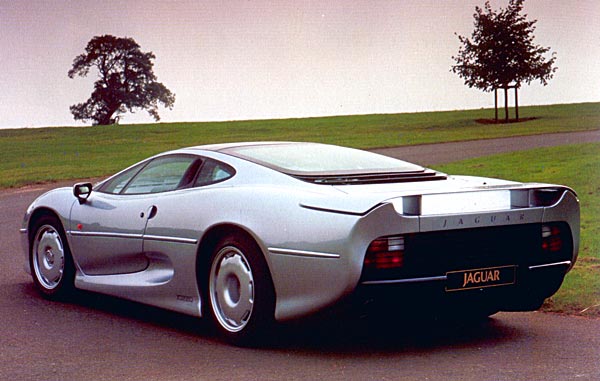
|
Announced as a prototype of which perhaps two
hundred and twenty could be built, the car soon had a flock of people trying to place orders with £50,000 deposits. Jaguar
couldn't possibly build it among the production lines, so the project was handed over to Jaguar Sport, the joint Jaguar-TWR
operation set up for niche variants and motor racing. TWR simplified the design, removing the 4WD, but sadly dropped the Jaguar
V-12 in favour of the turbocharged 3.5 litre V-6 which would become the chosen unit for Group C racing for 1989/90. Other
conceptual changes included shortening the car and using a chassis of aluminium honeycomb rather than sheet aluminium, but
it still looked broadly the same, had even more power at 550bhp and was 275Kg lighter than the original. A little over a year
after it's first showing, the heavily revised car was launched at £290,000 with a production quantity of 200-350. Three months
later in February 1990, this was confirmed at 350 with delivery to start two years later.
| Jaguar XJ220 |

|
Meanwhile, TWR had been gently developing a road-going
version of the XJR-9 which had won the 1988 Group C championship powered by a Jaguar V-12; this XJR9-R was running during
1989 and was finally announced as the XJR-15 in November 1990. While it was almost road-legal, it was launched for a one-make
racing series, accompanying selected Grand Prix meetings, and only twenty or so were to be built. There is no doubt that some
of the potential XJ220 owners would have prefered a road-going version of a real Jaguar racer than even the ultimate road-car,
but they had committed to their XJ220 purchase knowing that it was powered by the turbocharged V-6 and theXJR-15 was not technically
a road-car. In fact, the racing career of the XJR-15 was not particularly notable. The XJ220 is an electrifying road car.
When originally announced, it was claimed to be able exceed 200mph, reach 60mph in 3.6 seconds and 100mph in 8 seconds. In
it's final form it has clocked nearly 220mph, and returned 3.5 seconds to 60mph and 7.9 seconds to 100mph from a standing
start.
| Jaguar XJ220 |

|
The engine sits behind the two seat cabin, with
a tiny boot available behind that. The styling is heavily influenced by the need to cool the highly tuned engine and also
to provide sufficient downforce to keep the car steady at the 217mph top speed. It briefly held the top speed record for a
production car until the awesomely engineered McLaren F1 stole the title. So where are they now? A very rare sight on the
roads in the UK, you're more likely to see one on a race track. Many were made in left hand drive, and incredibly there are
some still to be found with delivery mileages only, in specialist car dealers around the UK. So sad that such a milestone
in Jaguar's history is so rarely seen. XJ220 owners - whip off your dust covers and share those beauties with the rest of
us!
| Jaguar XJ220 |

|
Jaguar XJ220 Specification:
Engine:
|
Twin turbo V6 aluminum alloy cylinder head and block
Twin
overhead camshaft per bank, 4 valves per cylinder |
| Displacement: |
3498cc (3.5L); 94mm bore x 84mm stroke |
| Compression Ratio: |
8.3 : 1 |
| Maximum Power: |
542 bhp @ 7200 rpm |
| Maximum Torque: |
475 ft. lb. @ 4500 rpm |
| Fuel System: |
Zytek electronic multi point sequential with electronic boost
control |
| Ignition System: |
Zytek electronic linked to injection |
|
Gearbox / Transaxle:
|
FF Developments all syncromesh 5 speed with triple cone syncroniser
on
first and second gears. Patented FF Developments viscous control
limited slip differential
| Ratios: |
1st |
3.000 |
| |
2nd |
1.95 |
| |
3rd |
1.42 |
| |
4th |
1.09 |
| |
5th |
0.85 |
Axle ratio 2.88 : 1 |
| Clutch: |
AP Racing twin plate 8.5 in |
Braking System:
|
AP Racing disc hydraulic
4 pot front and rear alloy calipers
330.2mm
x 35.5mm front discs ventilated outboard
300mm x 33.5mm rear discs ventilated outboard |
| Steering: |
Mechanical rack and pinion |
Suspension:
|
Four wheel independent unequal length wishbones
inboard
coil springs and dampers, anti roll bars |
Wheels:
|
Speedline one piece aluminum alloy rims
Front: 17" x 9";
Rear: 18" x 14" |
Tyres:
|
Bridgestone ZR rated Expedia
Front: 255/45 ZR17; Rear: 345/35
ZR18 |
| Aerodynamics: |
| Drag Cd |
0.36 |
Down Force CZ |
-.025 | |
Performance:
|
Top Speed 218 mph
0 - 60 mph in 3.6 seconds
0 - 100 mph
estimated in under 8.0 seconds
1/4 mile in 11.7 seconds @ 125 mph |
Dimensions:
|
| Overall length: |
4930mm |
| Overall width: |
2220mm (inc wing mirrors) |
| Height: |
1150mm |
| Wheelbase: |
2640mm |
| Weight |
1470kg | |
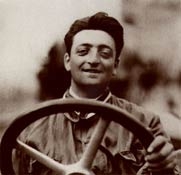
|

|

|


